Nursing Case Study: Ashanti's Presentation, Assessment, and Management
VerifiedAdded on 2022/09/12
|8
|2181
|29
Case Study
AI Summary
This assignment presents a nursing case study involving Ashanti, a 3-year-old indigenous girl, who presented at a remote clinic with symptoms including rapid bowel movements, lethargy, and dehydration. The case study analyzes Ashanti's condition through vital sign assessments, highlighting critical findings such as low blood pressure, low blood glucose, and rapid respiratory and heart rates. It includes an ISBAR handover communication with a doctor, detailing the situation, background, assessment, and recommendations for immediate referral to a rapid response team. The assignment further discusses the potential diagnoses of gastrocolic reflex, hypotension, and hypoglycemia, and outlines immediate nursing management, including intravenous glucose and rehydration. It explores the need for multidisciplinary healthcare professionals, including gastroenterologists, dietitians, and physiotherapists, to manage the condition effectively. The importance of dietary plans, family involvement, and ongoing monitoring is emphasized. The assignment concludes with a list of relevant references supporting the analysis and proposed treatment plans.
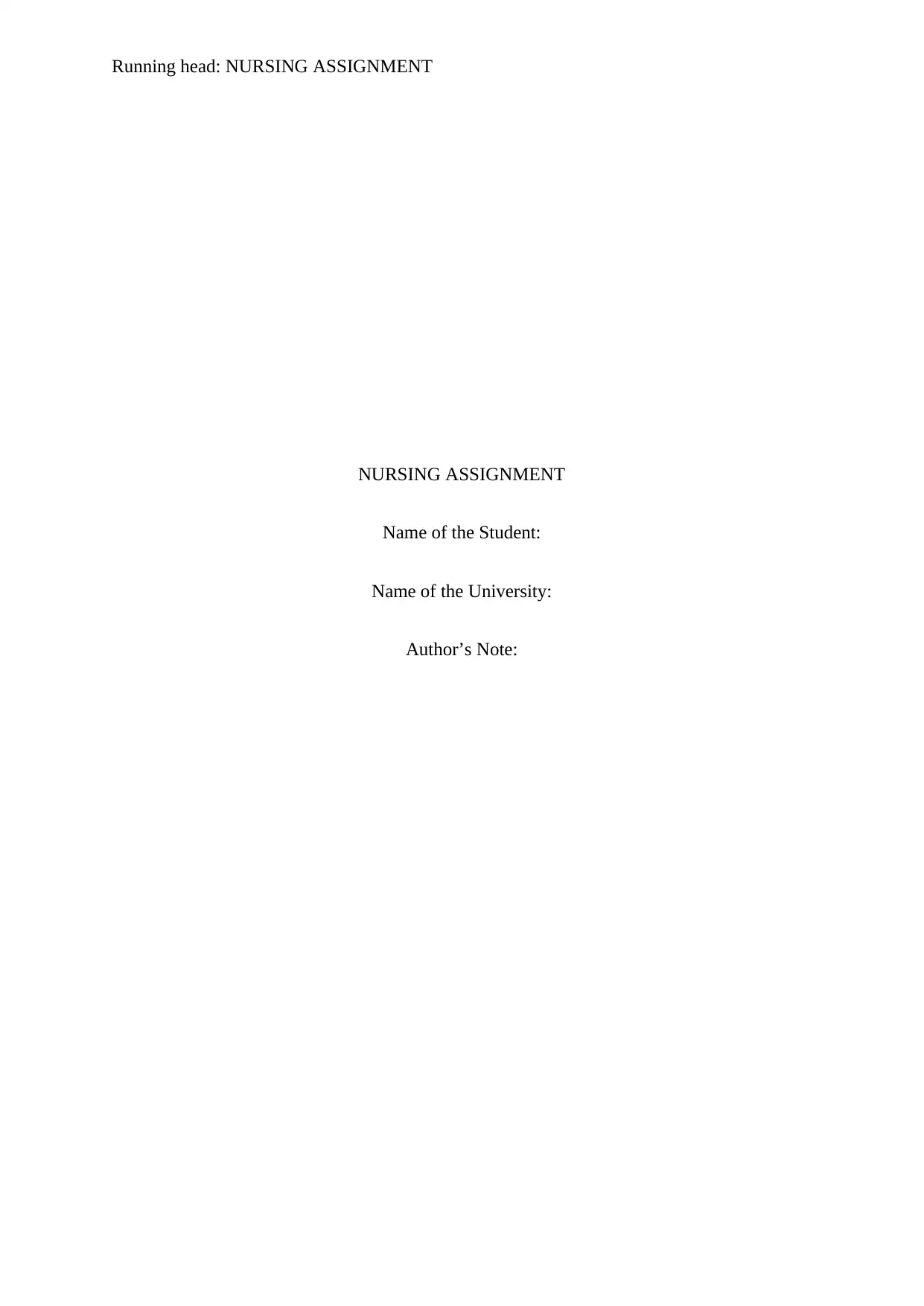
Running head: NURSING ASSIGNMENT
NURSING ASSIGNMENT
Name of the Student:
Name of the University:
Author’s Note:
NURSING ASSIGNMENT
Name of the Student:
Name of the University:
Author’s Note:
Paraphrase This Document
Need a fresh take? Get an instant paraphrase of this document with our AI Paraphraser
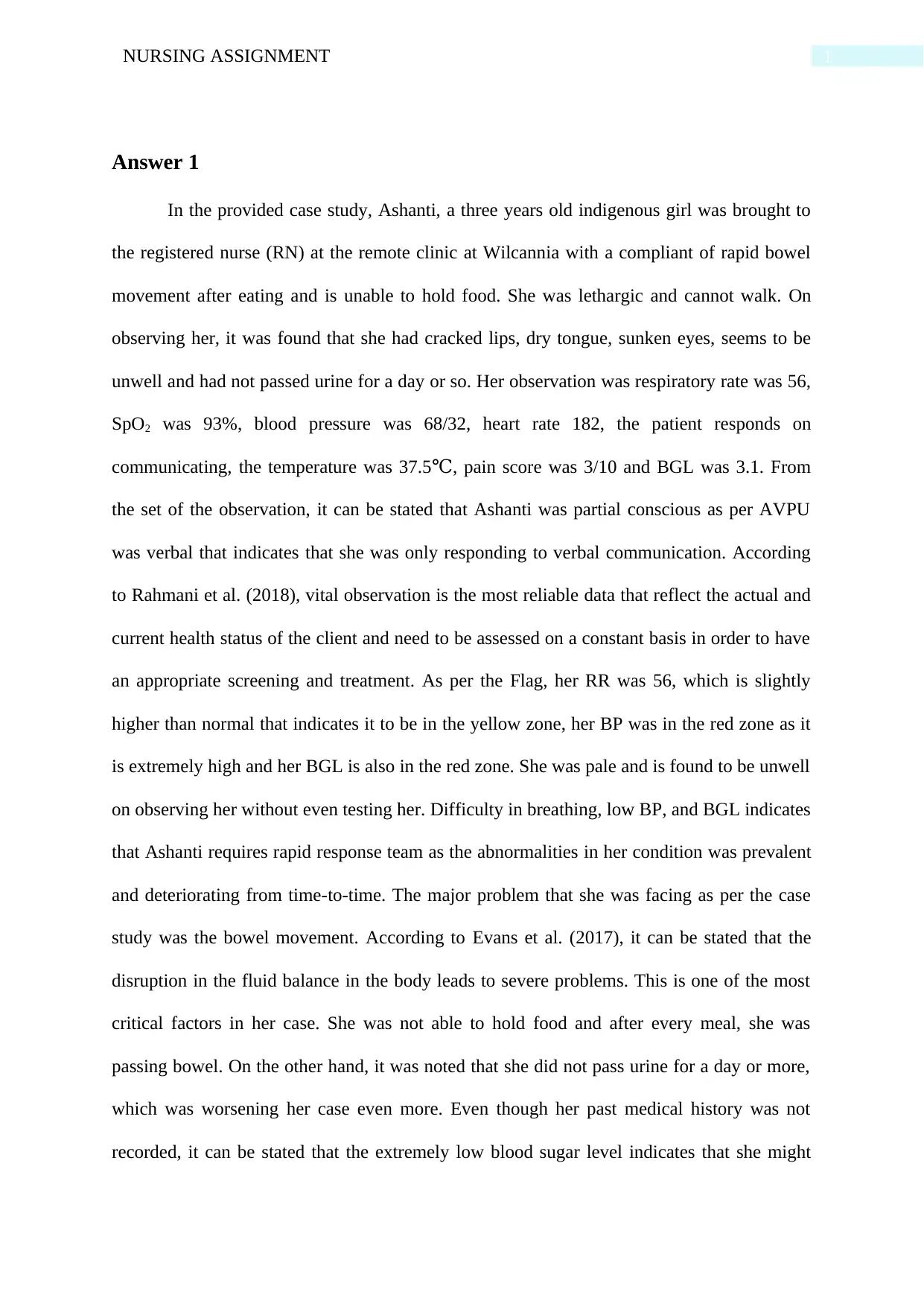
1NURSING ASSIGNMENT
Answer 1
In the provided case study, Ashanti, a three years old indigenous girl was brought to
the registered nurse (RN) at the remote clinic at Wilcannia with a compliant of rapid bowel
movement after eating and is unable to hold food. She was lethargic and cannot walk. On
observing her, it was found that she had cracked lips, dry tongue, sunken eyes, seems to be
unwell and had not passed urine for a day or so. Her observation was respiratory rate was 56,
SpO2 was 93%, blood pressure was 68/32, heart rate 182, the patient responds on
communicating, the temperature was 37.5℃, pain score was 3/10 and BGL was 3.1. From
the set of the observation, it can be stated that Ashanti was partial conscious as per AVPU
was verbal that indicates that she was only responding to verbal communication. According
to Rahmani et al. (2018), vital observation is the most reliable data that reflect the actual and
current health status of the client and need to be assessed on a constant basis in order to have
an appropriate screening and treatment. As per the Flag, her RR was 56, which is slightly
higher than normal that indicates it to be in the yellow zone, her BP was in the red zone as it
is extremely high and her BGL is also in the red zone. She was pale and is found to be unwell
on observing her without even testing her. Difficulty in breathing, low BP, and BGL indicates
that Ashanti requires rapid response team as the abnormalities in her condition was prevalent
and deteriorating from time-to-time. The major problem that she was facing as per the case
study was the bowel movement. According to Evans et al. (2017), it can be stated that the
disruption in the fluid balance in the body leads to severe problems. This is one of the most
critical factors in her case. She was not able to hold food and after every meal, she was
passing bowel. On the other hand, it was noted that she did not pass urine for a day or more,
which was worsening her case even more. Even though her past medical history was not
recorded, it can be stated that the extremely low blood sugar level indicates that she might
Answer 1
In the provided case study, Ashanti, a three years old indigenous girl was brought to
the registered nurse (RN) at the remote clinic at Wilcannia with a compliant of rapid bowel
movement after eating and is unable to hold food. She was lethargic and cannot walk. On
observing her, it was found that she had cracked lips, dry tongue, sunken eyes, seems to be
unwell and had not passed urine for a day or so. Her observation was respiratory rate was 56,
SpO2 was 93%, blood pressure was 68/32, heart rate 182, the patient responds on
communicating, the temperature was 37.5℃, pain score was 3/10 and BGL was 3.1. From
the set of the observation, it can be stated that Ashanti was partial conscious as per AVPU
was verbal that indicates that she was only responding to verbal communication. According
to Rahmani et al. (2018), vital observation is the most reliable data that reflect the actual and
current health status of the client and need to be assessed on a constant basis in order to have
an appropriate screening and treatment. As per the Flag, her RR was 56, which is slightly
higher than normal that indicates it to be in the yellow zone, her BP was in the red zone as it
is extremely high and her BGL is also in the red zone. She was pale and is found to be unwell
on observing her without even testing her. Difficulty in breathing, low BP, and BGL indicates
that Ashanti requires rapid response team as the abnormalities in her condition was prevalent
and deteriorating from time-to-time. The major problem that she was facing as per the case
study was the bowel movement. According to Evans et al. (2017), it can be stated that the
disruption in the fluid balance in the body leads to severe problems. This is one of the most
critical factors in her case. She was not able to hold food and after every meal, she was
passing bowel. On the other hand, it was noted that she did not pass urine for a day or more,
which was worsening her case even more. Even though her past medical history was not
recorded, it can be stated that the extremely low blood sugar level indicates that she might
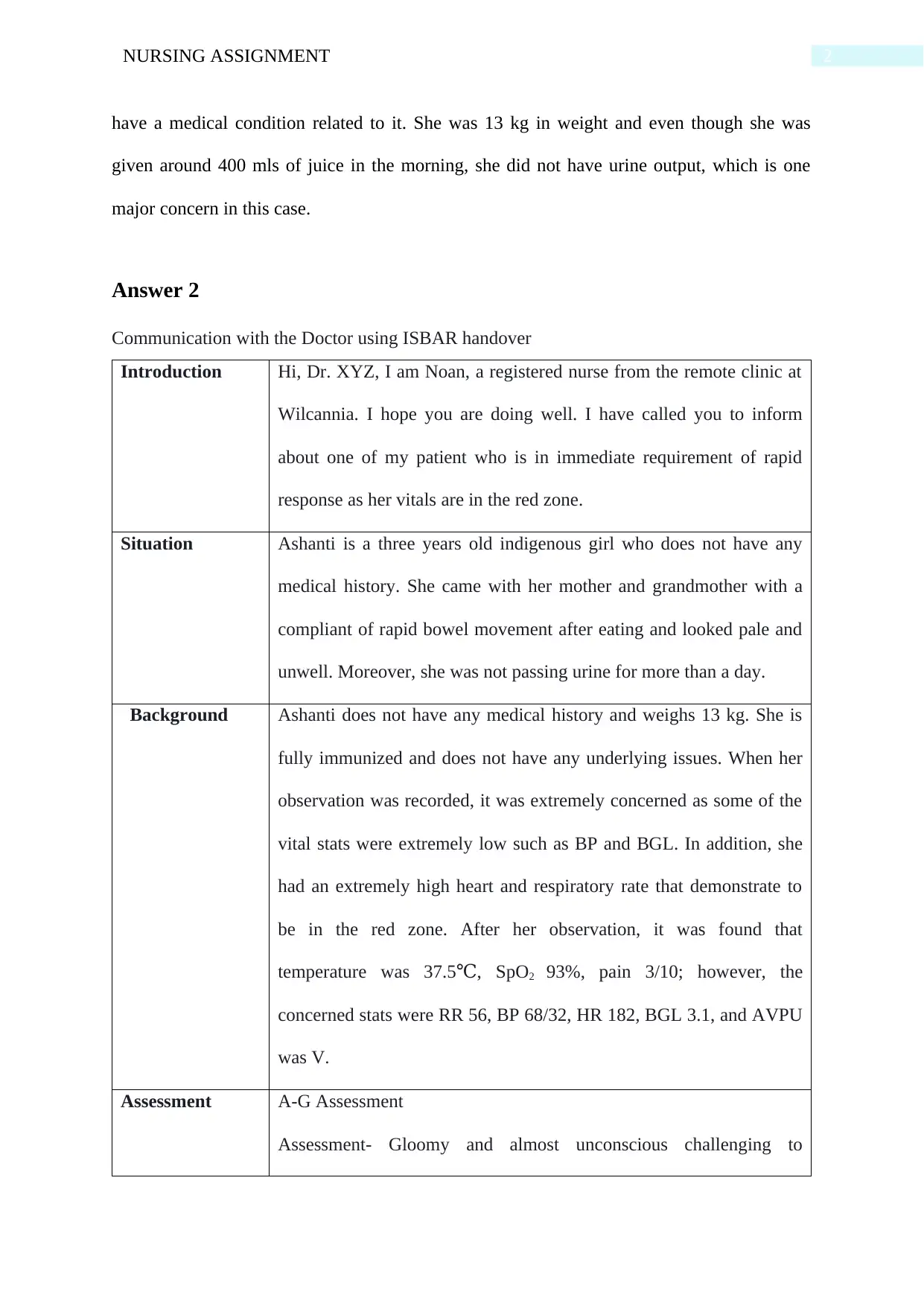
2NURSING ASSIGNMENT
have a medical condition related to it. She was 13 kg in weight and even though she was
given around 400 mls of juice in the morning, she did not have urine output, which is one
major concern in this case.
Answer 2
Communication with the Doctor using ISBAR handover
Introduction Hi, Dr. XYZ, I am Noan, a registered nurse from the remote clinic at
Wilcannia. I hope you are doing well. I have called you to inform
about one of my patient who is in immediate requirement of rapid
response as her vitals are in the red zone.
Situation Ashanti is a three years old indigenous girl who does not have any
medical history. She came with her mother and grandmother with a
compliant of rapid bowel movement after eating and looked pale and
unwell. Moreover, she was not passing urine for more than a day.
Background Ashanti does not have any medical history and weighs 13 kg. She is
fully immunized and does not have any underlying issues. When her
observation was recorded, it was extremely concerned as some of the
vital stats were extremely low such as BP and BGL. In addition, she
had an extremely high heart and respiratory rate that demonstrate to
be in the red zone. After her observation, it was found that
temperature was 37.5 , SpO℃ 2 93%, pain 3/10; however, the
concerned stats were RR 56, BP 68/32, HR 182, BGL 3.1, and AVPU
was V.
Assessment A-G Assessment
Assessment- Gloomy and almost unconscious challenging to
have a medical condition related to it. She was 13 kg in weight and even though she was
given around 400 mls of juice in the morning, she did not have urine output, which is one
major concern in this case.
Answer 2
Communication with the Doctor using ISBAR handover
Introduction Hi, Dr. XYZ, I am Noan, a registered nurse from the remote clinic at
Wilcannia. I hope you are doing well. I have called you to inform
about one of my patient who is in immediate requirement of rapid
response as her vitals are in the red zone.
Situation Ashanti is a three years old indigenous girl who does not have any
medical history. She came with her mother and grandmother with a
compliant of rapid bowel movement after eating and looked pale and
unwell. Moreover, she was not passing urine for more than a day.
Background Ashanti does not have any medical history and weighs 13 kg. She is
fully immunized and does not have any underlying issues. When her
observation was recorded, it was extremely concerned as some of the
vital stats were extremely low such as BP and BGL. In addition, she
had an extremely high heart and respiratory rate that demonstrate to
be in the red zone. After her observation, it was found that
temperature was 37.5 , SpO℃ 2 93%, pain 3/10; however, the
concerned stats were RR 56, BP 68/32, HR 182, BGL 3.1, and AVPU
was V.
Assessment A-G Assessment
Assessment- Gloomy and almost unconscious challenging to
⊘ This is a preview!⊘
Do you want full access?
Subscribe today to unlock all pages.

Trusted by 1+ million students worldwide
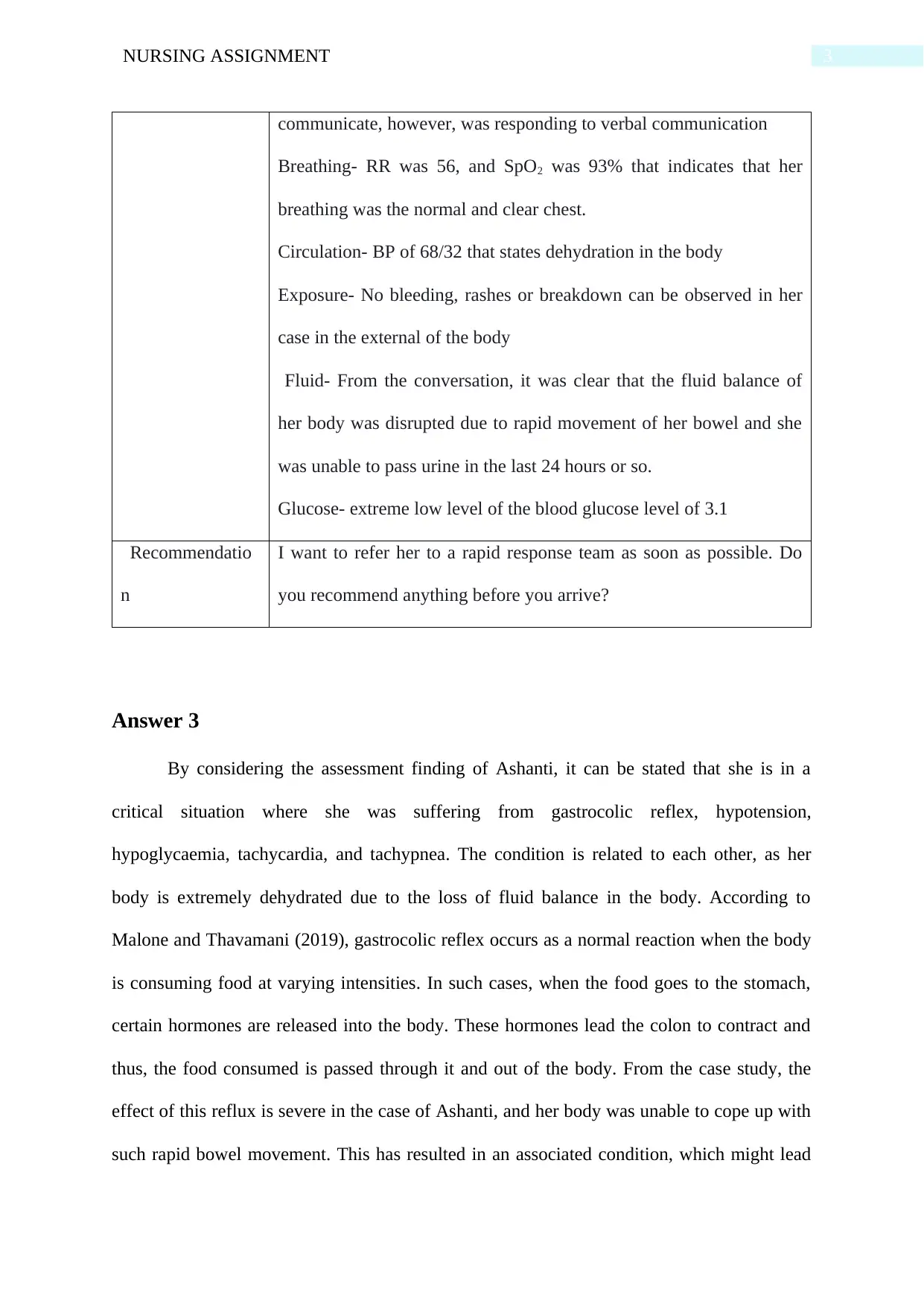
3NURSING ASSIGNMENT
communicate, however, was responding to verbal communication
Breathing- RR was 56, and SpO2 was 93% that indicates that her
breathing was the normal and clear chest.
Circulation- BP of 68/32 that states dehydration in the body
Exposure- No bleeding, rashes or breakdown can be observed in her
case in the external of the body
Fluid- From the conversation, it was clear that the fluid balance of
her body was disrupted due to rapid movement of her bowel and she
was unable to pass urine in the last 24 hours or so.
Glucose- extreme low level of the blood glucose level of 3.1
Recommendatio
n
I want to refer her to a rapid response team as soon as possible. Do
you recommend anything before you arrive?
Answer 3
By considering the assessment finding of Ashanti, it can be stated that she is in a
critical situation where she was suffering from gastrocolic reflex, hypotension,
hypoglycaemia, tachycardia, and tachypnea. The condition is related to each other, as her
body is extremely dehydrated due to the loss of fluid balance in the body. According to
Malone and Thavamani (2019), gastrocolic reflex occurs as a normal reaction when the body
is consuming food at varying intensities. In such cases, when the food goes to the stomach,
certain hormones are released into the body. These hormones lead the colon to contract and
thus, the food consumed is passed through it and out of the body. From the case study, the
effect of this reflux is severe in the case of Ashanti, and her body was unable to cope up with
such rapid bowel movement. This has resulted in an associated condition, which might lead
communicate, however, was responding to verbal communication
Breathing- RR was 56, and SpO2 was 93% that indicates that her
breathing was the normal and clear chest.
Circulation- BP of 68/32 that states dehydration in the body
Exposure- No bleeding, rashes or breakdown can be observed in her
case in the external of the body
Fluid- From the conversation, it was clear that the fluid balance of
her body was disrupted due to rapid movement of her bowel and she
was unable to pass urine in the last 24 hours or so.
Glucose- extreme low level of the blood glucose level of 3.1
Recommendatio
n
I want to refer her to a rapid response team as soon as possible. Do
you recommend anything before you arrive?
Answer 3
By considering the assessment finding of Ashanti, it can be stated that she is in a
critical situation where she was suffering from gastrocolic reflex, hypotension,
hypoglycaemia, tachycardia, and tachypnea. The condition is related to each other, as her
body is extremely dehydrated due to the loss of fluid balance in the body. According to
Malone and Thavamani (2019), gastrocolic reflex occurs as a normal reaction when the body
is consuming food at varying intensities. In such cases, when the food goes to the stomach,
certain hormones are released into the body. These hormones lead the colon to contract and
thus, the food consumed is passed through it and out of the body. From the case study, the
effect of this reflux is severe in the case of Ashanti, and her body was unable to cope up with
such rapid bowel movement. This has resulted in an associated condition, which might lead
Paraphrase This Document
Need a fresh take? Get an instant paraphrase of this document with our AI Paraphraser
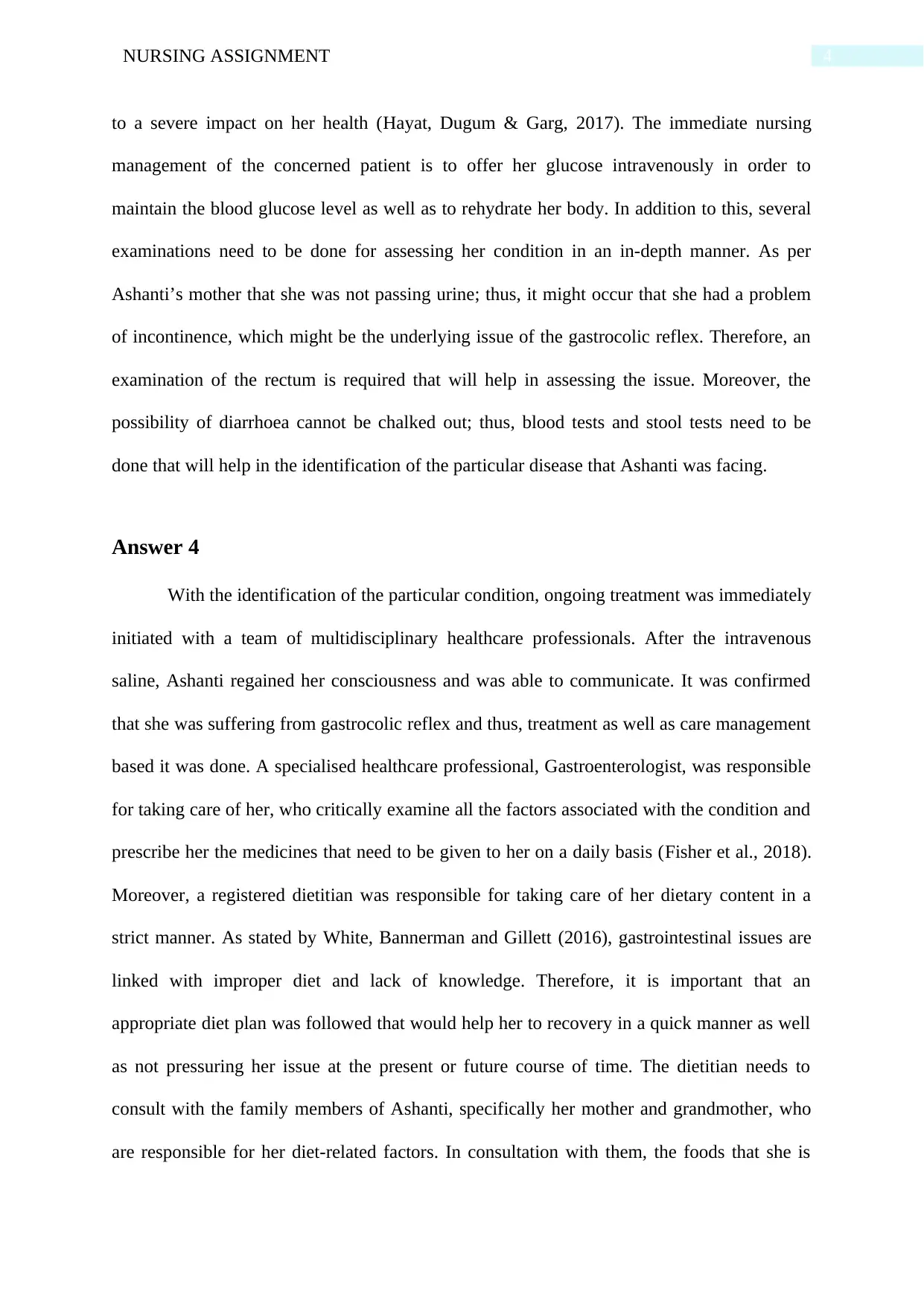
4NURSING ASSIGNMENT
to a severe impact on her health (Hayat, Dugum & Garg, 2017). The immediate nursing
management of the concerned patient is to offer her glucose intravenously in order to
maintain the blood glucose level as well as to rehydrate her body. In addition to this, several
examinations need to be done for assessing her condition in an in-depth manner. As per
Ashanti’s mother that she was not passing urine; thus, it might occur that she had a problem
of incontinence, which might be the underlying issue of the gastrocolic reflex. Therefore, an
examination of the rectum is required that will help in assessing the issue. Moreover, the
possibility of diarrhoea cannot be chalked out; thus, blood tests and stool tests need to be
done that will help in the identification of the particular disease that Ashanti was facing.
Answer 4
With the identification of the particular condition, ongoing treatment was immediately
initiated with a team of multidisciplinary healthcare professionals. After the intravenous
saline, Ashanti regained her consciousness and was able to communicate. It was confirmed
that she was suffering from gastrocolic reflex and thus, treatment as well as care management
based it was done. A specialised healthcare professional, Gastroenterologist, was responsible
for taking care of her, who critically examine all the factors associated with the condition and
prescribe her the medicines that need to be given to her on a daily basis (Fisher et al., 2018).
Moreover, a registered dietitian was responsible for taking care of her dietary content in a
strict manner. As stated by White, Bannerman and Gillett (2016), gastrointestinal issues are
linked with improper diet and lack of knowledge. Therefore, it is important that an
appropriate diet plan was followed that would help her to recovery in a quick manner as well
as not pressuring her issue at the present or future course of time. The dietitian needs to
consult with the family members of Ashanti, specifically her mother and grandmother, who
are responsible for her diet-related factors. In consultation with them, the foods that she is
to a severe impact on her health (Hayat, Dugum & Garg, 2017). The immediate nursing
management of the concerned patient is to offer her glucose intravenously in order to
maintain the blood glucose level as well as to rehydrate her body. In addition to this, several
examinations need to be done for assessing her condition in an in-depth manner. As per
Ashanti’s mother that she was not passing urine; thus, it might occur that she had a problem
of incontinence, which might be the underlying issue of the gastrocolic reflex. Therefore, an
examination of the rectum is required that will help in assessing the issue. Moreover, the
possibility of diarrhoea cannot be chalked out; thus, blood tests and stool tests need to be
done that will help in the identification of the particular disease that Ashanti was facing.
Answer 4
With the identification of the particular condition, ongoing treatment was immediately
initiated with a team of multidisciplinary healthcare professionals. After the intravenous
saline, Ashanti regained her consciousness and was able to communicate. It was confirmed
that she was suffering from gastrocolic reflex and thus, treatment as well as care management
based it was done. A specialised healthcare professional, Gastroenterologist, was responsible
for taking care of her, who critically examine all the factors associated with the condition and
prescribe her the medicines that need to be given to her on a daily basis (Fisher et al., 2018).
Moreover, a registered dietitian was responsible for taking care of her dietary content in a
strict manner. As stated by White, Bannerman and Gillett (2016), gastrointestinal issues are
linked with improper diet and lack of knowledge. Therefore, it is important that an
appropriate diet plan was followed that would help her to recovery in a quick manner as well
as not pressuring her issue at the present or future course of time. The dietitian needs to
consult with the family members of Ashanti, specifically her mother and grandmother, who
are responsible for her diet-related factors. In consultation with them, the foods that she is
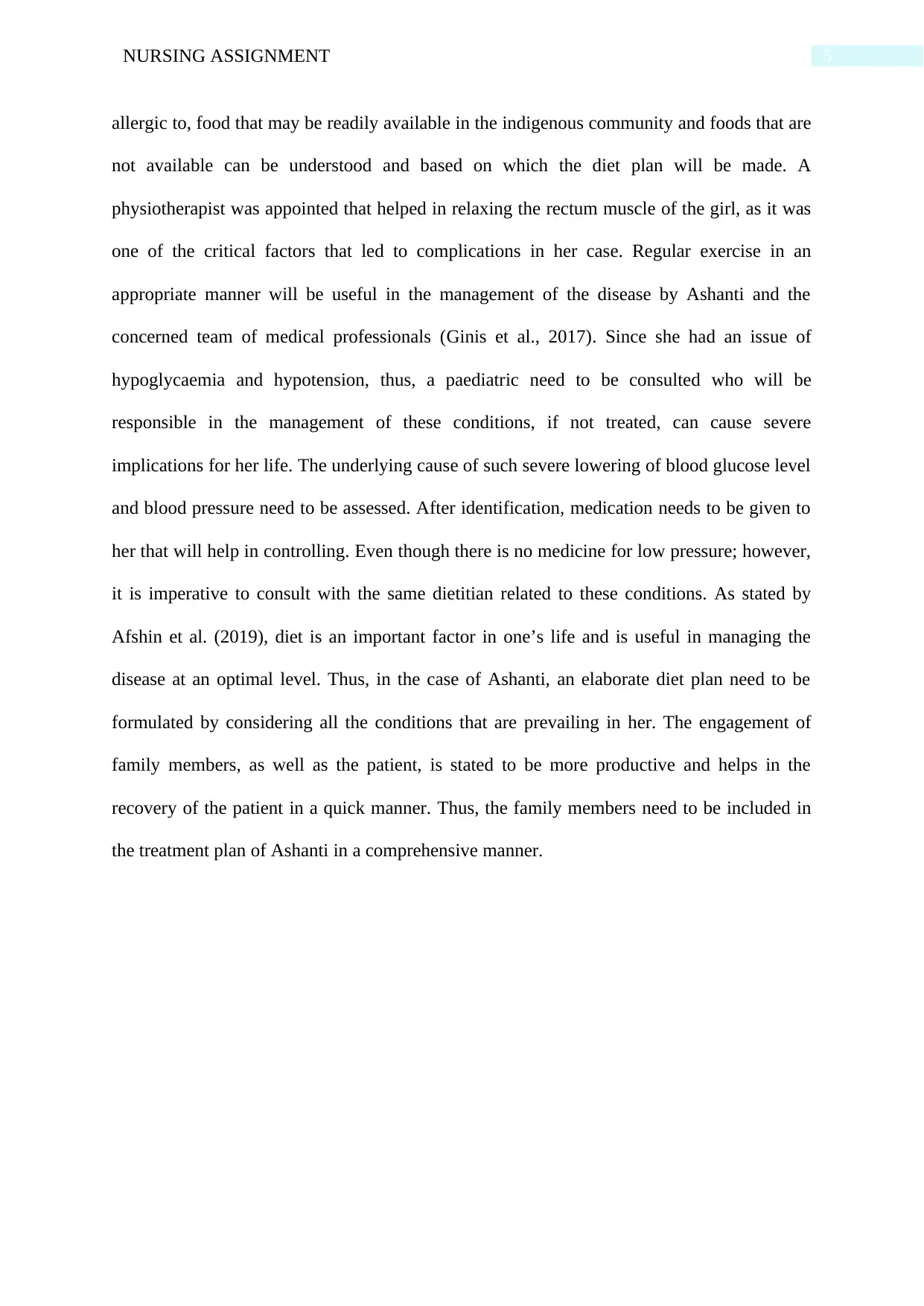
5NURSING ASSIGNMENT
allergic to, food that may be readily available in the indigenous community and foods that are
not available can be understood and based on which the diet plan will be made. A
physiotherapist was appointed that helped in relaxing the rectum muscle of the girl, as it was
one of the critical factors that led to complications in her case. Regular exercise in an
appropriate manner will be useful in the management of the disease by Ashanti and the
concerned team of medical professionals (Ginis et al., 2017). Since she had an issue of
hypoglycaemia and hypotension, thus, a paediatric need to be consulted who will be
responsible in the management of these conditions, if not treated, can cause severe
implications for her life. The underlying cause of such severe lowering of blood glucose level
and blood pressure need to be assessed. After identification, medication needs to be given to
her that will help in controlling. Even though there is no medicine for low pressure; however,
it is imperative to consult with the same dietitian related to these conditions. As stated by
Afshin et al. (2019), diet is an important factor in one’s life and is useful in managing the
disease at an optimal level. Thus, in the case of Ashanti, an elaborate diet plan need to be
formulated by considering all the conditions that are prevailing in her. The engagement of
family members, as well as the patient, is stated to be more productive and helps in the
recovery of the patient in a quick manner. Thus, the family members need to be included in
the treatment plan of Ashanti in a comprehensive manner.
allergic to, food that may be readily available in the indigenous community and foods that are
not available can be understood and based on which the diet plan will be made. A
physiotherapist was appointed that helped in relaxing the rectum muscle of the girl, as it was
one of the critical factors that led to complications in her case. Regular exercise in an
appropriate manner will be useful in the management of the disease by Ashanti and the
concerned team of medical professionals (Ginis et al., 2017). Since she had an issue of
hypoglycaemia and hypotension, thus, a paediatric need to be consulted who will be
responsible in the management of these conditions, if not treated, can cause severe
implications for her life. The underlying cause of such severe lowering of blood glucose level
and blood pressure need to be assessed. After identification, medication needs to be given to
her that will help in controlling. Even though there is no medicine for low pressure; however,
it is imperative to consult with the same dietitian related to these conditions. As stated by
Afshin et al. (2019), diet is an important factor in one’s life and is useful in managing the
disease at an optimal level. Thus, in the case of Ashanti, an elaborate diet plan need to be
formulated by considering all the conditions that are prevailing in her. The engagement of
family members, as well as the patient, is stated to be more productive and helps in the
recovery of the patient in a quick manner. Thus, the family members need to be included in
the treatment plan of Ashanti in a comprehensive manner.
⊘ This is a preview!⊘
Do you want full access?
Subscribe today to unlock all pages.

Trusted by 1+ million students worldwide
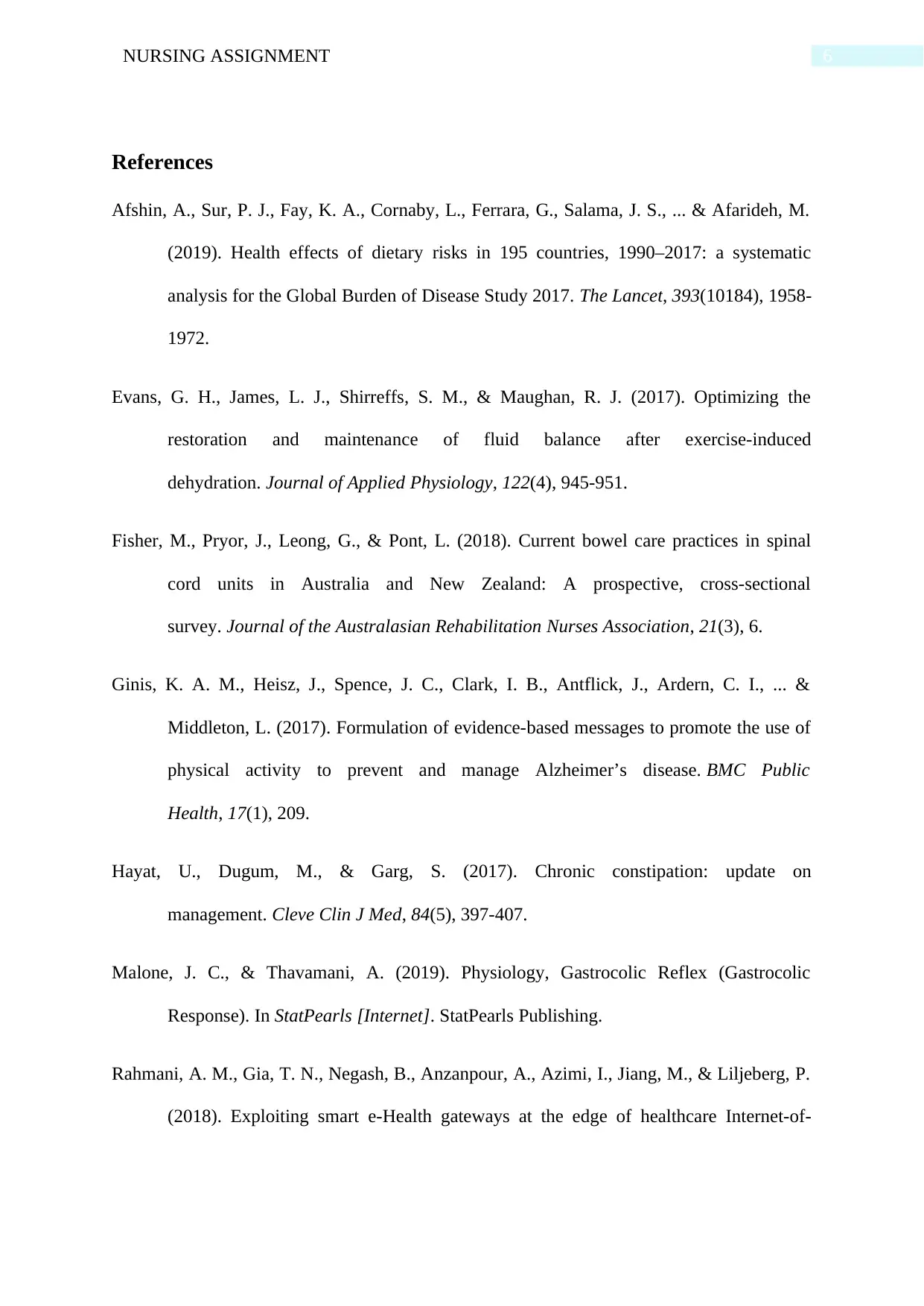
6NURSING ASSIGNMENT
References
Afshin, A., Sur, P. J., Fay, K. A., Cornaby, L., Ferrara, G., Salama, J. S., ... & Afarideh, M.
(2019). Health effects of dietary risks in 195 countries, 1990–2017: a systematic
analysis for the Global Burden of Disease Study 2017. The Lancet, 393(10184), 1958-
1972.
Evans, G. H., James, L. J., Shirreffs, S. M., & Maughan, R. J. (2017). Optimizing the
restoration and maintenance of fluid balance after exercise-induced
dehydration. Journal of Applied Physiology, 122(4), 945-951.
Fisher, M., Pryor, J., Leong, G., & Pont, L. (2018). Current bowel care practices in spinal
cord units in Australia and New Zealand: A prospective, cross-sectional
survey. Journal of the Australasian Rehabilitation Nurses Association, 21(3), 6.
Ginis, K. A. M., Heisz, J., Spence, J. C., Clark, I. B., Antflick, J., Ardern, C. I., ... &
Middleton, L. (2017). Formulation of evidence-based messages to promote the use of
physical activity to prevent and manage Alzheimer’s disease. BMC Public
Health, 17(1), 209.
Hayat, U., Dugum, M., & Garg, S. (2017). Chronic constipation: update on
management. Cleve Clin J Med, 84(5), 397-407.
Malone, J. C., & Thavamani, A. (2019). Physiology, Gastrocolic Reflex (Gastrocolic
Response). In StatPearls [Internet]. StatPearls Publishing.
Rahmani, A. M., Gia, T. N., Negash, B., Anzanpour, A., Azimi, I., Jiang, M., & Liljeberg, P.
(2018). Exploiting smart e-Health gateways at the edge of healthcare Internet-of-
References
Afshin, A., Sur, P. J., Fay, K. A., Cornaby, L., Ferrara, G., Salama, J. S., ... & Afarideh, M.
(2019). Health effects of dietary risks in 195 countries, 1990–2017: a systematic
analysis for the Global Burden of Disease Study 2017. The Lancet, 393(10184), 1958-
1972.
Evans, G. H., James, L. J., Shirreffs, S. M., & Maughan, R. J. (2017). Optimizing the
restoration and maintenance of fluid balance after exercise-induced
dehydration. Journal of Applied Physiology, 122(4), 945-951.
Fisher, M., Pryor, J., Leong, G., & Pont, L. (2018). Current bowel care practices in spinal
cord units in Australia and New Zealand: A prospective, cross-sectional
survey. Journal of the Australasian Rehabilitation Nurses Association, 21(3), 6.
Ginis, K. A. M., Heisz, J., Spence, J. C., Clark, I. B., Antflick, J., Ardern, C. I., ... &
Middleton, L. (2017). Formulation of evidence-based messages to promote the use of
physical activity to prevent and manage Alzheimer’s disease. BMC Public
Health, 17(1), 209.
Hayat, U., Dugum, M., & Garg, S. (2017). Chronic constipation: update on
management. Cleve Clin J Med, 84(5), 397-407.
Malone, J. C., & Thavamani, A. (2019). Physiology, Gastrocolic Reflex (Gastrocolic
Response). In StatPearls [Internet]. StatPearls Publishing.
Rahmani, A. M., Gia, T. N., Negash, B., Anzanpour, A., Azimi, I., Jiang, M., & Liljeberg, P.
(2018). Exploiting smart e-Health gateways at the edge of healthcare Internet-of-
Paraphrase This Document
Need a fresh take? Get an instant paraphrase of this document with our AI Paraphraser
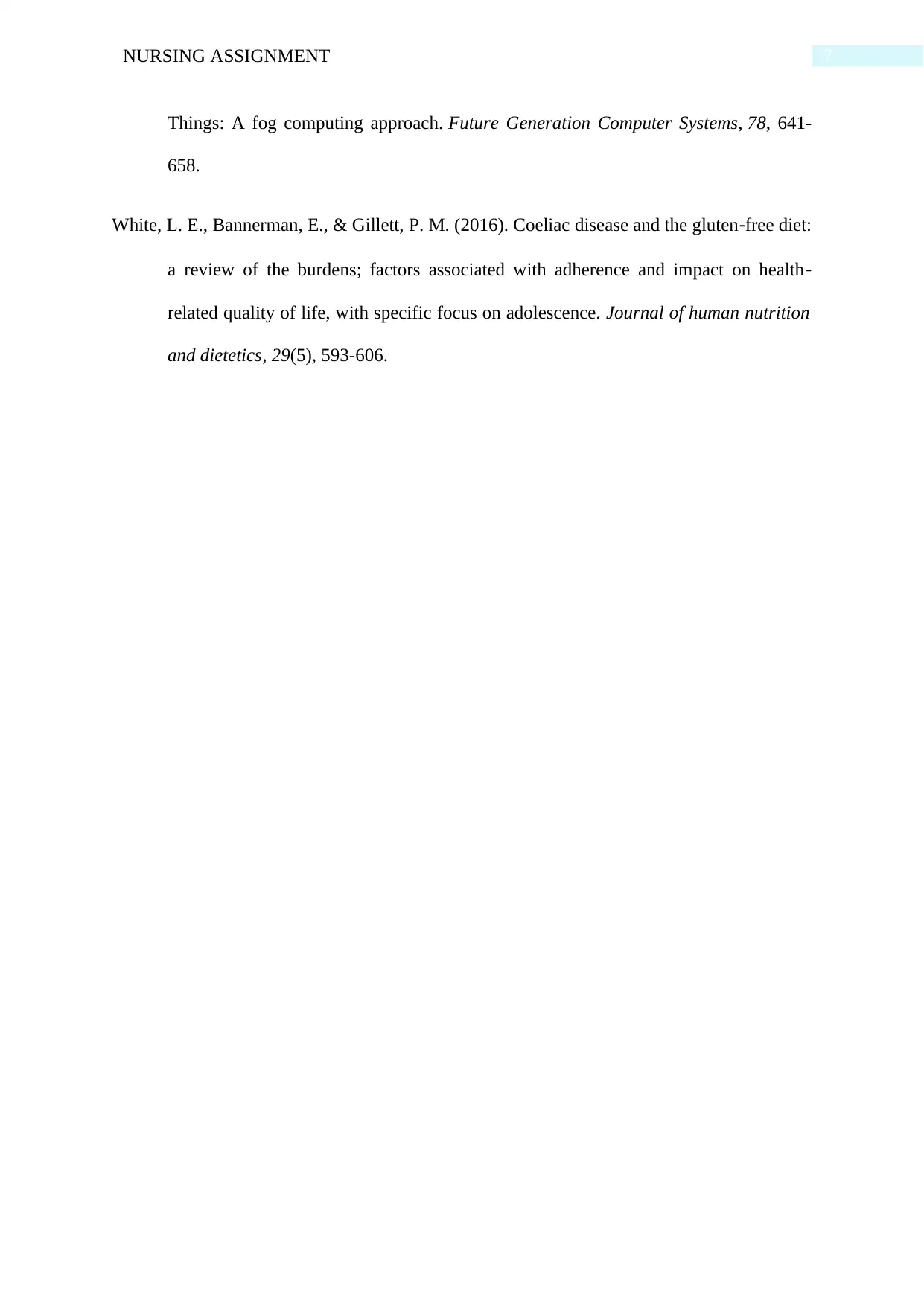
7NURSING ASSIGNMENT
Things: A fog computing approach. Future Generation Computer Systems, 78, 641-
658.
White, L. E., Bannerman, E., & Gillett, P. M. (2016). Coeliac disease and the gluten‐free diet:
a review of the burdens; factors associated with adherence and impact on health‐
related quality of life, with specific focus on adolescence. Journal of human nutrition
and dietetics, 29(5), 593-606.
Things: A fog computing approach. Future Generation Computer Systems, 78, 641-
658.
White, L. E., Bannerman, E., & Gillett, P. M. (2016). Coeliac disease and the gluten‐free diet:
a review of the burdens; factors associated with adherence and impact on health‐
related quality of life, with specific focus on adolescence. Journal of human nutrition
and dietetics, 29(5), 593-606.
1 out of 8
Your All-in-One AI-Powered Toolkit for Academic Success.
+13062052269
info@desklib.com
Available 24*7 on WhatsApp / Email
![[object Object]](/_next/static/media/star-bottom.7253800d.svg)
Unlock your academic potential
Copyright © 2020–2025 A2Z Services. All Rights Reserved. Developed and managed by ZUCOL.


